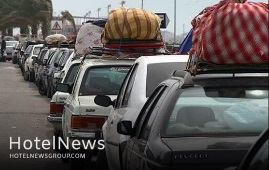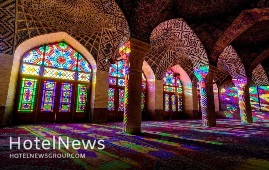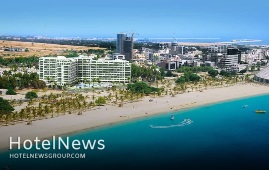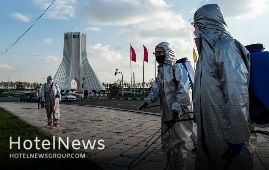
An archaeological discovery lately been made in the vicinity of Persepolis has shed new light on the once ceremonial capital of the Achaemenid empire. Excavations and surveys on Tall-e-Ajori, which is situated in the surrounding areas of the UNESCO-registered Persepolis, are expected to help archaeologists uncover more about the history of the royal city. Regarding the significance of such excavations around Persepolis, the director of the World Heritage site on Wednesday noted: “[Some] half of the ancient world was led and managed from the Persepolis.” There is ample evidence for the claim, which could be found across the Marvdasht plain, which is also home to the UNESCO-registered Pasargadae, and several historical sites as well as villages and small towns scattered in an area of 85,000 hectares around Persepolis, Hamid Fadaei added. However, protecting and preserving such a vast area would be a challenging and time-consuming task, he explained. The official also noted that besides the archeological significance, the ecosystem and natural resources, and capacities of the area should be taken into consideration. Supervised by a joint mission of Iranian and Italian archaeologists and cultural heritage experts, the excavations on Tall-e-Ajori uncovered vestiges of a massive gateway measuring 30 by 40 meters with a height of approximately 12 meters. The archaeologists succeeded in proving that Cyrus had ordered the construction of the gateway near Persepolis in Tall-e-Ajori and that this magnificent gateway had been put into operation during the reign of his son Cambyses. “The building had a corridor in the center, which was in form of a rectangular room measuring eight by twelve meters, and inside this central room, there were four living chairs. And the central corridor opened on both sides to the Achaemenid campus,” according to Alireza Askari-Charoudi who is a senior Iranian archaeologist. The royal city of Persepolis ranks among the archaeological sites which have no equivalent, considering its unique architecture, urban planning, construction technology, and art. Persepolis, also known as Takht-e Jamshid, whose magnificent ruins rest at the foot of Kuh-e Rahmat (Mountain of Mercy) is situated 60 kilometers northeast of the city of Shiraz in Fars province. The city was burnt by Alexander the Great in 330 BC apparently as revenge to the Persians because it seems the Persian King Xerxes had burnt the Greek City of Athens around 150 years earlier. The city’s immense terrace was begun about 518 BC by Darius the Great, the Achaemenid Empire’s king. On this terrace, successive kings erected a series of architecturally stunning palatial buildings, among them the massive Apadana palace and the Throne Hall (“Hundred-Column Hall”). This 13-ha ensemble of majestic approaches, monumental stairways, throne rooms (Apadana), reception rooms, and dependencies is classified among the world’s greatest archaeological sites. Persepolis was the seat of the government of the Achaemenid Empire, though it was designed primarily to be a showplace and spectacular center for the receptions and festivals of the kings and their empire. The site is marked by a large terrace with its east side abutting the Kuh-e Rahmat (“Mount of Mercy”). The other three sides are formed by a retaining wall, varying in height with the slope of the ground from 13 to 41 feet (4 to 12 meters); on the west side, a magnificent double stair in two flights of 111 short stone steps leads to the top. On the terrace are the ruins of several colossal buildings, all constructed of a dark gray stone (often polished to a marble-like surface) from the adjacent mountain. According to Britannica, the stone was cut with the utmost precision into blocks of great size, which were laid without mortar; many of them are still in place. Especially striking are the huge columns, 13 of which still stand in the audience hall of Darius I (the Great; reigned 522–486 BC), known as the Apadana, the name given to a similar hall built by Darius at Susa. There are two more columns still standing in the entrance hall of the Gate of Xerxes, and a third has been assembled there from its broken pieces. In 1933 two sets of gold and silver plates recording in the three forms of cuneiform—ancient Persian, Elamite, and Babylonian—the boundaries of the Persian empire were discovered in the foundations of Darius’s hall of audience. Several inscriptions, cut in stone, of Darius I, Xerxes I, and Artaxerxes III indicate to which monarch the various buildings were attributed.
Create: Mar 6, 2021 Edit: Mar 6, 2021 Regional News
The reasonable prices of Iran tours are expected to bring back the boom into the tourism sector of the country in post coronavirus era, the head of the Iranian Tour Operators Association has said. “Attractive tour plans are also being prepared for those who are eager to explore the historical attractions and natural wonders of the ancient country and want to experience a vacation here,” Ebrahim Pourfaraj said on Thursday. He also expressed hope that international tour operators and companies who have worked with their Iranian counterparts for years, would put Iran back on the world’s travel route again, considering the facilities they can get at cheaper prices than in other countries. Referring to health tourism as a popular branch in Iran, he noted that medical services in Iran are provided at a lower price than what may be offered at double the price in other countries. Back in January, the official announced that the tourist flow from across the world to Iran will return to normal in 2022. Although there are requests for traveling to Iran in the current year (2021), most travel agencies and tour operators believe that the flow will go back to normal in the next year, he explained. Beginning mass vaccination against the coronavirus will provide better and safe conditions for international travels in 2022, he added. Last November, the World Tourism Organization announced that international tourist arrivals to Iran plunged 72% during the first eight months of 2020 when compared to 2019, highlighting the severe impact of COVID-19 as the main factor. Cultural Heritage, Tourism, and Handicrafts Minister Ali-Asghar Mounesan in October warned that Iran’s cultural heritage and tourism will be in a critical situation if the crises caused by the outbreak of the coronavirus continue. Last August, Mounesan said that Iran’s tourism has suffered a loss of 12 trillion rials (some $2.85 billion) since the outbreak of the coronavirus pandemic. He also noted that the coronavirus pandemic should not bring traveling to a complete standstill. “Corona is a fact, but can the virus stop tourism? Certainly not. For us, the coronavirus is a new experience in dealing with crises that teaches tourism experts around the world how to deal with such a disaster, and thankfully governments are turning this into an opportunity for better planning.” Optimistic forecasts, however, expect Iran to achieve a tourism boom after coronavirus contained, believing its impact would be temporary and short-lived for a country that ranked the third fastest-growing tourism destination in 2019. The latest available data show eight million tourists visited the Islamic Republic during the first ten months of the past Iranian calendar year (started March 21, 2019). Iran welcomed some 7.8 million foreign nationals a year earlier, achieving a 52.5 percent increase year on year. The ancient land embraces hundreds of historical sites such as bazaars, museums, mosques, bridges, bathhouses, madrasas, mausoleums, churches, towers, and mansions, of which 24 being inscribed on the UNESCO World Heritage list. Under the 2025 Tourism Vision Plan, the country aims to increase the number of tourist arrivals from 4.8 million in 2014 to 20 million in 2025.
Create: Mar 6, 2021 Edit: Mar 6, 2021 Regional News
The Iranian government has paid 6.5 trillion rials ($154.7 million at the official exchange rate of 42,000 rials per dollar) in loans to the tourism businesses affected by the coronavirus pandemic across the country in the current Iranian year 1399 (started on March 20, 2020), the tourism minister has said. Although the coronavirus outbreak has caused significant damage to the tourism industry, one of the ministry’s strategic plans is to diversify tourism products, which is expected to expand economic prosperity, Ali-Asghar Mounesan announced on Monday. Several historical structures and aging buildings have been revived and repurposed into different accommodation centers to attract more domestic and foreign travelers, he added. In recent years, nature tourism has also gained popularity due to the country’s natural beauty and attractions, he explained. In this regard, several eco-lodge units have been established even in the farthest regions of the country as well, the minister noted. Elsewhere in his remarks, he expressed hope that limited Noruz trips would be possible, if practiced under health protocols, during the Iranian New Year vacations, which begins on March 21. Government’s care and support packages Last October, the deputy tourism chief, Vali Teymouri, announced that a new support package was approved to pay loans to businesses affected by the coronavirus pandemic. Depending on the type and activity of the businesses, they could benefit from at least 160 million rials ($3,800 at the official rate of 42,000 rials) to nine billion rials ($214,000) of bank loans with a 12-percent interest rate, he said. The loans would be allocated to tourist guides, travel agencies, tourism transport companies, tourism educational institutions, eco-lodges and traditional accommodations, hotels, apartment hotels, motels, and guesthouses as well as traditional accommodation centers, tourism complexes, and recreational centers, the official explained. Teymouri in September pointed to the 1.3 million tourism workers in the country, who are facing several issues due to the coronavirus crisis and said “This number, in addition to their households, includes a significant population that makes a living through tourism, who are needed to be considered in ministry’s decisions.” Back in August, Teymouri announced that the tourism ministry had approved a total budget of 4,920 billion rials (over $117 million) to support corona-affected tourism businesses, covering as much as 36,000 people working in the tourism sector. Tourism industry in critical situation Mounesan in October warned that Iran’s cultural heritage and tourism would be in a critical situation if the crises caused by the outbreak of the coronavirus continue. Last August, the tourism minister said that the tourism sector of the Islamic Republic had suffered a loss of 12 trillion rials (some $2.85 billion) since the outbreak of the coronavirus pandemic. He also noted that the coronavirus pandemic should not bring traveling to a complete standstill. “Corona is a fact, but can the virus stop tourism? Certainly not. For us, the coronavirus is a new experience in dealing with crises that teaches tourism experts around the world how to deal with such a disaster, and thankfully governments are turning this into an opportunity for better planning.” Optimistic forecasts, however, expect Iran to achieve a tourism boom after coronavirus contained, believing its impact would be temporary and short-lived for a country that ranked the third fastest-growing tourism destination in 2019. The latest available data show eight million tourists visited the Islamic Republic during the first ten months of the past Iranian calendar year (started March 21, 2019).
Create: Mar 3, 2021 Edit: Mar 3, 2021 Regional News
On Sunday, Mohammad Hassan Zibakhsh, the spokesman of Iran's Civil Aviation Organization (CAO), announced that all flights to and from 32 countries have been suspended due to the latest decision of the National Headquarters for Coronavirus Control, IRIB reported. The new restrictions also limit travels between the Islamic Republic and England, Angola, Bolivia, Botswana, Burundi, Cape Verde, Chile, Colombia, Democratic Republic of the Congo, Ecuador, Eswatini, French Guinea, Lesotho, Guyana, Malawi, Mauritania, Mauritania, Rwanda, Sicily, Suriname, Tanzania, Uruguay, Venezuela, and Zambia. Regarding the admission status of travelers from countries with special conditions, the official said: “For direct or indirect flights to Iran, passengers, who have stayed in one of the cited countries for more than four hours within a maximum of two weeks before the date of travel, will not be able to enter the Islamic Republic of Iran until further notice.” Earlier this month, Iran announced it would reduce the validity of negative COVID-19 PCR test results from 96 hours to 72 hours for inbound and outbound passengers. The new regulation replaced a role that required to bar passengers from boarding if they do not have a negative COVID test within 96 hours of departure. All passengers are subject to the medical screening on arrival, and if they are suspected of having the disease, non-Iranian nationalities will be quarantined at a place specified by the Health Ministry at their own expense and Iranian citizens will need to self-isolate for 14 days. The worldwide outbreak of COVID-19 has brought the world to a standstill, and tourism has been the worst affected of all major economic sectors. World tourist arrivals fell by 72% over the first ten months of 2020, according to data compiled by the World Tourism Organization (UNWTO) in December. Restrictions on travel, low consumer confidence, and a global struggle to contain the coronavirus pandemic are amongst factors contributing to the worst year on record in the history of tourism. Iran has also suffered the same fate as its foreign arrivals plunged 72% during the first eight months of 2020 when compared to 2019.
Create: Mar 2, 2021 Edit: Mar 2, 2021 Regional News
Cultural Heritage, Tourism, and Handicrafts Minister Ali-Asghar Mounesan on Sunday signed a memorandum of understanding (MOU) with Transport and Urban Development Minister Mohammad Eslami to deepen cooperation and expand bilateral ties. The MOU aims at developing maritime tourism and make the best use of its potential in the southern and northern coasts of the country, according to a press release issued by the tourism ministry. Promoting the culture of using the sea as a tool to increase social vitality, development of coastal activities in the form of environmentally-friendly plans and programs, and creating the necessary grounds for cooperation and exchange of knowledge and information were also among the topics of the agreement. The traditional skills of building and sailing Iranian Lenj boats in the Persian Gulf was another issue discussed by the two ministers to find a way to safeguard the endangered UNESCO-registered tradition for future generations. Speaking on the sidelines of the signing ceremony, Mounesan said that the tourism ministry tries its best to leave single product tourism behind and diversify tourism products. A focus on the country’s natural capacities along with the historical and cultural capacities could attract more domestic and foreign tourists as well as create more job opportunities in some deprived areas, he explained. He also expressed hope that constructing seaside hotels on the northern and southern coasts and bringing the international cruise ships would also boost maritime tourism in the country. For his part, Eslami said that having a well-organized program for the development of beaches and the use of marine recreation is a priority for the transport ministry. Over the past couple of years, the Islamic Republic has made various efforts to exploit maritime tourism potential by developing hospitality infrastructures, diversifying sea routes, and drawing private sector investors along its vast southern coasts. Prosperous maritime tourism could help the county to meet its ambitious target of attracting 20 million annual tourists by 2025. It also keeps an eye on tourism developments in the Caspian Sea in the north.
Create: Mar 2, 2021 Edit: Mar 2, 2021 Regional News
“I invite all [potential] travelers who are interested in culture to visit Iran and see that Iran is a peaceful and hospitable country,” Venezuela’s Minister of Tourism and Foreign Trade Ali Padron Paredes has said. “I am stunned by the beauties of Isfahan”, Padron Paredes added in an interview with CHTN on Thursday while touring the ancient city during his four-day visit to the Islamic Republic. The minister had toured several travel destinations and museums in Kerman before flying to Isfahan. He called his visit to Kerman as memorable. “I convey to the people and the government of Iran greetings of the people and the government of Venezuela.” “I enjoyed the journey to Iran and I want to experience this pleasure again. Iran has very hospitable and friendly people who are also friendly with the Venezuelan people,” the minister stated. Before setting off for Isfahan, Padron Paredes and his Iranian counterpart Ali-Asghar Mounesan inked a memorandum of understanding to deepen mutual tourism ties. Back in October, Mounesan exchanged views with former Venezuelan Tourism and Foreign Trade Minister Felix, Ramon Plasencia Gonzalez, in a video conference to deepen tourism relations, especially through simplifying visa rules, launching fam tours, and setting up exhibits. They also agreed to sign a memorandum of understanding in a bid to broaden bilateral ties. Last November, Mounesan said that visa-free access and direct flights are the two important advantages for Iran and Venezuela to develop tourism cooperation. The relationship between Venezuela and Iran became more serious following an official visit by the then Venezuelan President Hugo Chavez to Tehran in 2001. Isfahan, the capital of a province of the same name, is nicknamed “Nesf-e-Jahan” which is translated into “half the world”, meaning it contains fully half of the world's wonders. In its heyday, it was also one of the largest cities in the region with a population of nearly one million. The cool blue tiles of Isfahan's Islamic buildings, and the city's majestic bridges, contrast perfectly with the encircling hot, dry Iranian countryside. Big and sprawling Kerman is something of a cultural melting pot, blending various regional cultures over time. It is also home to rich tourist spots and historical sites including bazaars, mosques, caravanserais, and ruins of ancient urban areas.
Create: Feb 26, 2021 Edit: Feb 26, 2021 International News
Iran’s Cultural Heritage, Tourism and Handicrafts Ministry has gained official permission for organizing limited intercity travels during the Iran New Year vacations, which begins on March 21. “We have obtained permission for limited Noruz trips from the National Headquarters for Coronavirus Control,” the deputy tourism minister, Vali Teymouri, announced on Tuesday. With less than a month to go till the start of the Iranian New Year, which has long been associated with millions of domestic travels, the ministry wants to find a way to partially revive the already-slumped travels in the face of the COVID-19 pandemic. “The tourism ministry has held several meetings with the National Headquarters for the Coronavirus Control during with we discussed the issues in detail. Based on our strategies, we proposed two travel models that can be implemented following health protocols in the country,” Teymouri said last week. The first [working] model for travels in the Iranian New Year, proposes travels by the means of package tours. “Throughout package tours, travelers benefit from services provided by the tour and they will stay in authorized accommodation centers [and destinations] which are under the supervision of the Ministry of Cultural Heritage, Tourism and Handicrafts,” the official explained. For the second model, people do not go on tours, but when traveling to their destination city, they must stay in authorized accommodation centers, which are under the supervision of the ministry, to comply with all health protocols and maintain public health, Teymouri stated. Any other form of accommodation would be prohibited to curb the virus, he said. “To help prevent the spread of the coronavirus in Noruz 1400, the establishment of tourist camps, camping, tourists staying in places such as schools, shrines, husseiniyahs, etc. is prohibited, and this issue has been announced to the provincial governors.” The arteria of Noruz travels is expected to be announced in detail during the upcoming exhibition for tourism and handicrafts, which will be held in near future, according to the official. The tourism minister, Ali-Asghar Mounesan, publicized in November that mass, unplanned travels are not approved. “The outbreak of the coronavirus has caused damage to the tourism industry in Iran and [other parts of] the world in such a way that according to statistics, 50 million people are directly and indirectly exposed to unemployment due to the virus spread in the global scene…. yet, mass or unplanned and irresponsible travels are not approved to take place during the coronavirus era.” Smart and responsible traveling should replace "do not travel” recommendations, the minister stressed, adding: “In our country, Corona has caused problems in the tourism industry and the worrying point is the continuation of this trend.” “We are well aware of what the National Headquarters for Coronavirus Control proclaims [the health protocols], hence as a proposal, we have formulated some smart, responsible travel packages by the implementation of which we could have secure travels,” the minister said. He has repeatedly announced that his ministry is in full coordination with the Ministry of Health for strictly implementing health protocols in travel destinations, hospitably centers, and museums, amongst others, underlining that “people’s health is our priority.” Iranians traditionally make hundreds of thousands of domestic trips during the New Year holidays, when most businesses and workplaces are closed, as are schools.
Create: Feb 24, 2021 Edit: Feb 24, 2021 Regional News
Iran’s tourism industry has suffered a loss of some 220 trillion rials (about $5.2 billion at the official exchange rate of 42,000 rials per dollar) since the outbreak of the coronavirus pandemic, Cultural Heritage, Tourism, and Handicrafts Minister said on Tuesday. “Iran’s tourism has suffered some 220 trillion rials due to corona pandemic so far…. and we hope that with the production of domestic vaccines, tourism will flourish in 1400 [the new Iranian calendar year which begins on March 21],” Ali-Asghar Mounesan said. He made the remarks during the opening ceremony of Tehran’s international tourism and handicrafts fair, which is currently underway at Tehran Permanent International Fairgrounds. “We hope that the widespread vaccine would bring prosperity to all branches of tourism such as agritourism, ecotourism, and nature tourism,” the minister said. “Over 1.5 million jobs have been lost in the tourism sector of Iran due to the COVID-19 disease…. Many of the tourism-insiders are now unemployed or they are staying at home,” Mounesan announced last December. The government had previously allocated a total of 500 trillion rials (about $12 billion) to the corona-affected sectors, of which 200 trillion rials ($4.7 billion) will be given to the health ministry and the rest will be spent on other sectors, he explained. Last month, the minister announced that the national budget bill for the next calendar year (starting on March 20) has proposed 70 trillion rials (about $1.7 billion) to support tourism businesses affected by the coronavirus pandemic. If the budget receives parliament’s approval, it will be injected into different sectors of the tourism industry, which has taken a major hit from the coronavirus outbreak over the previous months, he noted. Despite the toughest economic pressures and sanctions, the government has provided good support to all sectors of tourism, the minister said. However, there is hope that the beginning of mass vaccination against the coronavirus will provide better conditions for tourism and businesses related to this sector, he explained. Government’s care and support packages In late October, the deputy tourism minister, Vali Teymouri, announced that a new support package to pay loans to businesses affected by the coronavirus pandemic has been approved. Depending on the type and activity of the businesses, they could benefit from at least 160 million rials ($3,800) to nine billion rials ($214,000) of bank loans with a 12-percent interest rate, he said. The loans will be allocated to tourist guides, travel agencies, tourism transport companies, tourism educational institutions, eco-lodges and traditional accommodations, hotels, apartment hotels, motels, and guesthouses as well as traditional accommodation centers, tourism complexes, and recreational centers, the official explained. Teymouri pointed to the 1.3 million tourism workers in the country, who are facing several issues due to the coronavirus crisis, and said “This number, in addition to their households, includes a significant population that makes a living through tourism, who are needed to be considered in ministry’s decisions.” Teymouri has said that the tourism ministry has approved a total budget of 4,920 billion rials (over $117 million) to support corona-affected tourism businesses, covering as much as 36,000 people working in the tourism sector.
Create: Feb 24, 2021 Edit: Feb 24, 2021 Regional News
Iranian tourism minister Ali-Asghar Mounesan and his deputy for handicrafts, Pouya Mahmoudian, honored some exemplary crafters and artisans on Saturday. Behruz Zarindashti in ceramic and Sara Hedayat in costume designing received Silver Cypress, during the closing ceremony of the 5th Fajr national handicrafts festival, one of Iran’s major crafts shows held in the National Museum of Iran. Furthermore, Zeinab Masudi in illumination, Abbas Jalalikia in woodwork, Saru Moqerchian in metalwork, and Vajiheh Sadat Jalali in woodcarving received honorable mentions, according to organizers. Two the recently-deceased veteran crafters; Ahmad Shishegar, who was a master of tilework, and Amir Saeim, a master of toreutics, were honored posthumously during the ceremony, which was attended by tens of artists, crafters, and cultural officials as well. Over 150 crafters practicing different fields of handicrafts participated in this edition of the festival, of which several were honored during the ceremony. This edition of the festival, which brings together works from all over the country and is a venue for showcasing tens of ancient and modern Iranian handicrafts, was held entirely online due to the coronavirus outbreak. The event showcased woodwork, illuminated manuscript, miniature, textile printing, enamel, leatherwork, calligraphy, metalwork, mirrorwork, and marquetry, among others. It also featured potteries, ceramics, personal ornamentation, rugs, and kilim carpets. With 14 entries, Iran ranks first globally for the number of cities and villages registered by the World Crafts Council, as China with seven entries, Chile with four, and India with three ones come next. In January 2020, the cities of Shiraz, Malayer, and Zanjan and the village of Qassemabad were designated by the WCC- Asia Pacific Region, putting Iran’s number of world crafts cities and villages from ten to 14. Shiraz was named a “world city of [diverse] handicrafts”. Malayer was made a global hub for woodcarving and carved-wood furniture. Zanjan gained the title of a “world city of filigree”. And Qassemabad village, which is nationally known for its traditional costumes, was also promoted to a world hub of handicrafts. Chador Shab, a kind of homemade outer-garment for women, was, however, the main subject for the WCC assessment for the village. Iran exported $523 million worth of handicrafts during the calendar year 1398 (ended March 19, 2020). Of the figure, some $273 million worth of handicrafts were exported officially through customs, and about $250 million was earned via suitcase trade (allowed for customs-free and tax-free transfer) through various provinces, according to data provided by the Ministry of Cultural Heritage, Tourism and Handicrafts. Ceramics, pottery vessels, handwoven cloths as well as personal ornamentations with precious and semi-precious gemstones are traditionally exported to Iraq, Afghanistan, Germany, the U.S., the UK, and other countries.
Create: Feb 22, 2021 Edit: Feb 22, 2021 Regional News
The country’s largest beach park is planned to be established in the Persian Gulf island of Kish, southern Iran. Hundreds of hectares of coastal lands on Kish Island have been ratified to be turned into a beach park, which would be the largest of its kind in the country, the CEO of Kish Civil, Water, and Urban Services Abolfazl Tayyebi said on Saturday. One of [public] benefits from the implementation of this project is that some 388,000 square meters of valuable beaches will not be ceded to the private sector, the official added. In many cities and countries of the world, nowadays, most of the beaches are owned by individuals and the private sector, and due to construction near the sea, they are out of reach of people and tourists, the official explained. With such a project and establishing facilities for the public on the island’s coastline, no one could encroach on this precious treasure that belongs to all Iranians, he noted. Amongst the Persian Gulf islands, Kish is the more luxurious and developed. Except for its unique nature such as waters and shallow beaches, the tourist attractions of this charming island are due to its rich historical background as well as kind and hospitable people. About one million foreign and domestic tourists travel to the island every year and it is one of the most popular tourist destinations in Iran as it has magnificent attractions such as Kariz Underground City, Harireh Ancient City, Greek Ship, and Grand Recreational Pier to name a few.
Create: Feb 21, 2021 Edit: Feb 21, 2021 Regional News
The number of foreign visitors to Iran plunged 94% in the first nine months of the current Iranian calendar year (started March 20, 2020), from a year earlier, government data showed on Wednesday, as the coronavirus pandemic takes a heavy toll of the tourism industry. “Some 450,000 foreign travelers arrived in Iran for mainly medical or trade purposes during the first nine months of the year… tightened measures to tackle the new coronavirus has reduced international travel to the country by 94 percent,” Vali Teymouri, the deputy tourism minister, announced on Wednesday. The global tourism industry has been plagued by the outbreak of the coronavirus for more than a year, which is a record in the history of this industry, the official noted. In an interview with the Tehran Times, the official noted: “We need to revise marketing strategies, and to redefine tourism products by paying great attention to nature tours, rural tourism, and ecotourism, agricultural tourism as a tool to empower local communities and travel businesses.” The coronavirus epidemic has ruined more than 1.5 million jobs in Iran’s travel sector, tourism minister Ali-Asghar Mounesan said in December. “Over 1.5 million jobs have been lost in the tourism sector of Iran due to the COVID-19 disease…. Many of the tourism-insiders are now unemployed or they are staying at home,” Mounesan said. The county’s travel sector has suffered a loss of 140 trillion rials (some $3.3 billion at the official rate of 42,000 rials) since the outbreak of the coronavirus pandemic till the end of Shahrivar (Sep. 21), the official added. Mounesan publicized last November that mass, unplanned travels are not approved, adding: “The outbreak of the coronavirus has caused damage to the tourism industry in Iran and [other parts of] the world in such a way that according to statistics, 50 million people are directly and indirectly exposed to unemployment due to the virus spread in the global scene…. yet, mass or unplanned and irresponsible travels are not approved to take place during the coronavirus era.” Smart and responsible traveling should replace "do not travel” recommendations, the minister stressed, adding: “In our country, Corona has caused problems in the tourism industry and the worrying point is the continuation of this trend.” Tourism [industry of Iran] was growing before the corona [outbreak], its revenues reached $11.7 billion in 2019, which accounted for 2.8% of GDP, near the average share of tourism in the world GDP, which was 3.2 percent, the minister explained. He said 8.7 million foreign nationals visited Iran during the past [Iranian] year (1398), adding that Iran was ranked as the second fastest-growing country in tourism based on data compiled by the World Tourism Organization. “On the onset of coronavirus, tourism faced a sharp decline in the world including our country. So that in the first three months of the current [Iranian] year the number of foreign tourists dropped to 74 --- it was reached almost zero!.”
Create: Feb 20, 2021 Edit: Feb 20, 2021 Regional News
With a month to go till the start of the Iranian New Year, which has long been associated with millions of domestic travels, the Iranian tourism minister wants to find a way to partially revive the already-slumped travels in the face of the COVID-19 pandemic. “The tourism ministry has held several meetings with the National Headquarters for the Coronavirus Control during with we discussed the issues in detail. Based on our strategies, we proposed two travel models that can be implemented following health protocols in the country,” ISNA quoted Vali Teymouri, the deputy tourism minister, as saying on Thursday. The first [working] model for travels in the Iranian New Year, proposes travels by the means of package tours. “Throughout package tours, travelers benefit from services provided by the tour and they will definitely stay in authorized accommodation centers [and destinations] which are under the supervision of the Ministry of Cultural Heritage, Tourism and Handicrafts,” the official explained. For the second model, people do not go on tours, but when traveling to their destination city, they must stay in authorized accommodation centers, which are under the supervision of the ministry, to comply with all health protocols and maintain public health, Teymouri explained. Any other form of accommodation would be prohibited to curb the virus, he said. “To help prevent the spread of the coronavirus in Noruz 1400, the establishment of tourist camps, camping, tourists staying in places such as schools, shrines, husseiniyahs, etc. is prohibited, and this issue has been announced to the provincial governors.” The arteria of Noruz travels is expected to be announced in detail during the upcoming exhibition for tourism and handicrafts, which will be held in near future, he said. Cultural Heritage, Tourism and Handicrafts Minister Ali-Asghar Mounesan publicized in November that mass, unplanned travels are not approved. “The outbreak of the coronavirus has caused damage to the tourism industry in Iran and [other parts of] the world in such a way that according to statistics, 50 million people are directly and indirectly exposed to unemployment due to the virus spread in the global scene…. yet, mass or unplanned and irresponsible travels are not approved to take place during the coronavirus era.” Smart and responsible traveling should replace "do not travel” recommendations, the minister stressed, adding: “In our country, Corona has caused problems in the tourism industry and the worrying point is the continuation of this trend.” “We are well aware of what the National Headquarters for Coronavirus Control proclaims [the health protocols], hence as a proposal, we have formulated some smart, responsible travel packages by the implementation of which we could have secure travels,” the minister said. He has repeatedly announced that his ministry is in full coordination with the Ministry of Health for strictly implementing health protocols in travel destinations, hospitably centers, and museums, amongst others, underlining that “people’s health is our priority.” Tourism [industry of Iran] was growing before the corona [outbreak], its revenues reached $11.7 billion in 2019, which accounted for 2.8% of GDP, near the average share of tourism in the world GDP, which was 3.2 percent, the minister explained. Iranians traditionally make hundreds of thousands of domestic trips during the New Year holidays, when most businesses and workplaces are closed, as are schools.
Create: Feb 20, 2021 Edit: Feb 20, 2021 Regional News
